Original author: Will Awang
Original source: Web3 Lawyer
Whether stablecoins can reshape the global financial landscape is no longer a question of YES/NO, but a question of how to reshape it.
In the early days, the growth of stablecoins was measured by total supply. The key challenge was the trust behind it: which issuers were trustworthy, compliant, and capable of scalability. I believe that with the introduction of the US Genius Act, this problem will be solved soon.
With the standardization of issuance, the stablecoin market enters the next stage - from Mint to Distribution.
The days of issuers making staggering profits are numbered — distributors are beginning to realize their leverage and get their fair share of value. This is well explained in Circle’s prospectus.
Given this shift, it is becoming increasingly important to first understand which applications, protocols, and platforms are achieving real growth, especially for those on-chain stablecoin scenarios that are already relatively mature in the crypto market.
Last week, we compiled an article called Artemis: First-line data from stablecoin payment adoption, which looked at the potential and path of stablecoins linking traditional finance from the perspective of stablecoin scenarios for off-chain payments.
Today, we continue to delve deeper into the stablecoin research report Artemis, The Future of Stablecoins, Usage, Revenue, and the Shift from Issuers to Distribution, focusing on stablecoin use cases related to on-chain activities, because each use case has its own unique background and practice. At the same time, it is also possible to observe the value capture trend in the dynamic market changes on the chain.
Key Points
Although the market value of stablecoins has reached 240 billion US dollars and the annual transaction volume is as high as 3.1 trillion US dollars, there are many misunderstandings about their popularity. On the one hand, in order to expand the market, issuers pay high fees to distributors. For example, Circle paid $900 million to distributors such as Coinbase in 2023, accounting for more than half of its revenue, in order to attract users to use USDC.
On the other hand, the so-called annual trading volume of US$3.1 trillion is extremely misleading, of which 31% comes from the contribution of MEV robots through thousands of cycles every day, repeatedly using the same funds. The actual trading volume actually participated by humans is far lower than the scale implied by the surface data.
In addition, there is an over-concentration of wealth in the stablecoin field that is little known. Although there are currently 150 million stablecoin wallets, 99% of the wallets have a balance of less than US$10,000, and only 20,000 mysterious wallets control US$76 billion, accounting for 32% of the total supply. These wallets are neither exchanges nor DeFi protocols and are reported to be classified as a gray area, and the meaning behind them is still unclear.
It is worth noting that the real explosive growth of stablecoins has occurred in the past six months. Since the summer, DeFi stablecoin trading volume has soared from US$100 billion to US$600 billion. At the same time, meme coin transactions alone have generated US$500 billion in stablecoin flow, accounting for 12% of annual trading volume.
However, the criteria we use to measure the success of stablecoins are reversed. A decrease in total locked value (TVL) may not be a decrease in usage, but may instead be a reflection of technological progress and improved efficiency, while an increase in trading volume may simply mean an increase in robot activity. There are fundamental problems with each of the indicators we use to track adoption.
While people are still arguing about the market share of USDC and USDT, the real change is actually happening quietly at the distribution level. As a result, it may lead to a reshaping of the entire stablecoin ecological value chain.
1. The next stage of stablecoins
In just a few years, stablecoins have evolved from experimental products to indispensable financial tools, and their product-market fit is unquestionable. But now, we have entered a new period where issuance and liquidity alone are not enough to bring sustained growth. The next stage of stablecoin adoption will involve new factors, including sharing economic benefits with partners, the ease of on-chain and off-chain integration, and the degree to which programmable features can be utilized. - Jelena Djuric, co-founder and CEO of Noble
1.1 Behind the 240 billion supply
Stablecoins have become one of the most widely used products in the crypto space, with a supply of over $240 billion and annual on-chain transaction volume exceeding $7 trillion, comparable in size to traditional payment networks, but many of the numbers are worth digging into.
Supply reflects the amount of stablecoins in existence, not how much they are used, where they are flowing, or what they are used for. Meanwhile, volume reflects a mix of on-chain human activity and bots, but fails to capture off-chain data.
1.2 Usage is a new signal
Not all stablecoins are in a state of efficient value circulation. Some stablecoins are dormant as node verification or staking, while others are key drivers of cross-platform, cross-user, and cross-regional real economic activities.
As described in the State of Stablecoins in 2025, we see clear differences between stablecoins in different ecosystems. Stablecoins on Ethereum tend to be used as DeFi collateral and trading liquidity, while stablecoins on TRON are more commonly used for remittances and payments in emerging markets. USDC has a higher share of institutional funding flows, while USDT thrives on its reach and accessibility.
These usage patterns not only reflect where value flows, but also provide builders with opportunities to target underserved or high-growth niches.
Understanding the application scenarios of stablecoins and their functional utility is the clearest signal for considering stablecoins at present, indicating where stablecoins are truly adopted and where the next wave of innovation will emerge.
2. From Institutional Issuance to Market Distribution
Stablecoins will grow further, and regulatory clarity is opening the door for institutional investors. The next phase of stablecoins is not only about who has scale, but also about the business models of all participants in the stablecoin supply chain, including issuers, distributors, and holders. In the next 12-24 months, we will definitely see changes and challenges in the value chain and value capture. -Martin Carrica, Vice President of Stablecoins at Anchorage Digital
2.1 Historical Value of the Issuer
In the early days of stablecoins, value capture was primarily concentrated on the issuer. Maintaining a 1:1 peg at massive scale is a difficult problem that few issuers have been able to solve well.
Tether and Circle have been able to dominate not only because they were first movers but also because they are among the few issuers that can consistently manage the complex tasks of large-scale issuance and redemption, managing reserves, integrating with banking partners, and withstanding market stress.
By monetizing reserve yields (primarily short-term U.S. Treasuries and cash equivalents), even modest interest rates can translate into huge revenues. Meanwhile, early successes are compounding: exchanges, wallets, and DeFi protocols built around USDT and USDC reinforce the network effects of issuance and liquidity.
2.2 Distributors as an important value layer
Trusted custody, liquidity, and redemption are no longer differentiators, but expectations. As more and more issuers with similar capabilities enter the market, the importance of the issuer itself decreases.
What matters is what users can do with stablecoins. Therefore, the dominance of stablecoins is shifting from issuers to distributors.
Distributors Wallets, exchanges, and applications that integrate stablecoins into real-world use cases now hold both influence and leverage. They control user relationships, shape the user experience, and increasingly determine which stablecoins gain traction.
And they’re monetizing that status. Circle’s recent IPO filing shows that it paid nearly $900 million to partners like Coinbase to integrate and promote USDC, more than half of its total revenue in 2023.
Note that the issuer pays the distributor, not the other way around.

(Circle S-1 Form)
Many distributors are further enhancing their platform architecture. PayPal launched PYUSD; Telegram partnered with Ethena; Meta is exploring stablecoin channels again; and fintech platforms such as Stripe, Robinhood, and Revolut are embedding stablecoins directly into payment, savings, and trading functions.
Issuers are not standing still either. Tether is building wallets and payment rails. Circle is moving full stack with payment APIs, developer tools, and infrastructure acquisitions, while launching the Circle Payment Network in hopes of creating a network effect.
But one thing is clear: distribution is now the strategic high ground.
We are in the midst of a tectonic shift: a shift in perspective, where stablecoins are no longer viewed as “cryptocurrencies” but as “global infrastructure”; a shift in utility, where financial institutions are taking full advantage of these new rails to actively reshape their products; and a changing competitive environment.
—Ran Goldi, Senior Vice President of Payments and Networking at Fireblocks
2.3 Build Programmability and Precision
As stablecoins gain popularity, new infrastructure is emerging—infrastructure designed to enable programmability, compliance, and value sharing. Issuance alone is no longer the key. To remain competitive, stablecoins must be able to adapt to the needs of the platforms that drive usage.
The next generation of stablecoins includes programmable features such as cross-checking capabilities, compliance rules, and conditional transfers. These features enable stablecoins to act as application-aware assets that automatically route value to merchants, developers, liquidity providers (LPs), or affiliates without the need for off-chain protocols.
Each use case has its own unique context. Remittances prioritize speed and conversion, DeFi requires composability and collateral flexibility, and FinTech integrations require compliance and auditability. The emerging infrastructure stack is designed to meet these diverse needs, enabling the stablecoin layer to dynamically adapt to its environment rather than providing a one-size-fits-all solution.
Crucially, this infrastructure shift enables more precise value capture. Programmable flows mean value can be shared across the stack, not just hoarded by the issuer. Stablecoins are becoming dynamic financial primitives, influenced by the incentives and architecture of the ecosystem in which they exist.
3. On-chain stablecoin use cases
As the value capture of stablecoins moves downstream, it is the distributors who define their actual use.
Wallets, exchanges, fintech applications, payment platforms, and DeFi protocols determine which stablecoins users can see, how they interact with them, and where they create utility. These platforms shape the user experience and control the demand side of the stablecoin economy.
Analyzing the actual use of stablecoins in areas such as payments, savings, trading, DeFi, and remittances can reveal who is creating value, where the friction points are, and which distribution channels are effective. This report focuses on stablecoin use cases related to on-chain activities. By tracking the flow of stablecoins in wallets and platforms, etc., we can gain insight into the infrastructure and incentives that influence their adoption.
Among these known (also called “tokenized”) players, current stablecoin usage is concentrated in three main contexts:
Centralized Exchanges
DeFi Protocols
MEV
The following table shows the supply and transaction volume share of each category in April 2025:

These three types of addresses together account for 38% of the total stablecoin supply and 63% of the total stablecoin transaction volume.
Untagged addresses account for the majority of the remaining supply and transaction volume. These wallets are not directly associated with well-known institutions, exchanges, or smart contracts. We will explore trends in untagged addresses later in this report.
3.1 Overview of the overall stablecoin market
Total stablecoin supply: $240 billion
Total stablecoin trading volume in the past 30 days: $3.1 trillion
Reserve income: $10 billion
A. Supply
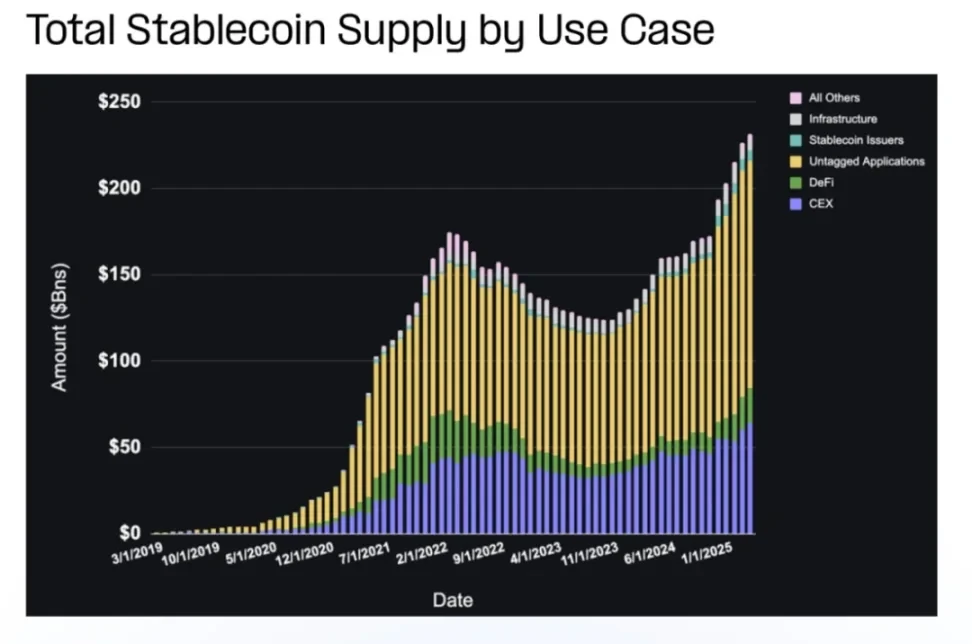
The distribution of stablecoin supply (Supply) reveals which platforms and use cases are attractive enough to attract and retain circulation. Since the summer of 2023, the total stablecoin supply has been steadily climbing, hitting an all-time high this year, with centralized exchanges (CEX), DeFi, and unlabeled wallets all achieving high growth in supply.
Most stablecoin supply is concentrated on centralized exchanges, with Binance holding a sizable lead. DeFi protocols and issuers also have a significant share.
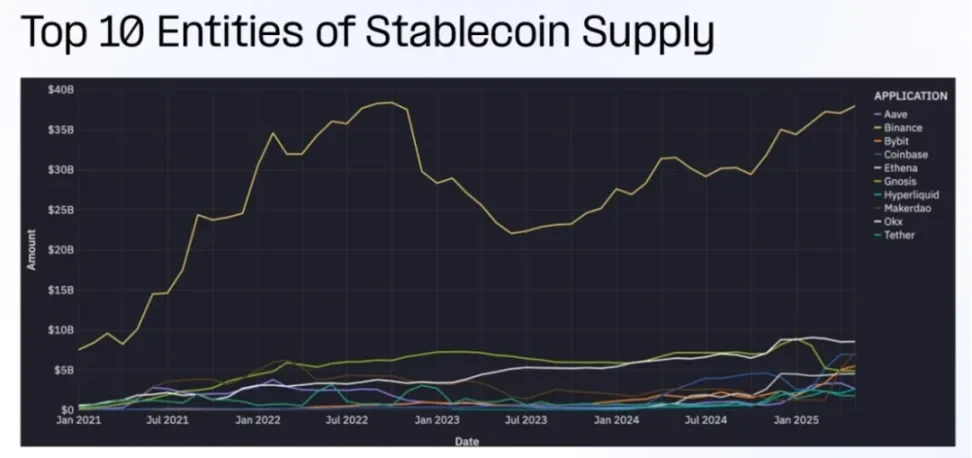
B. Volume
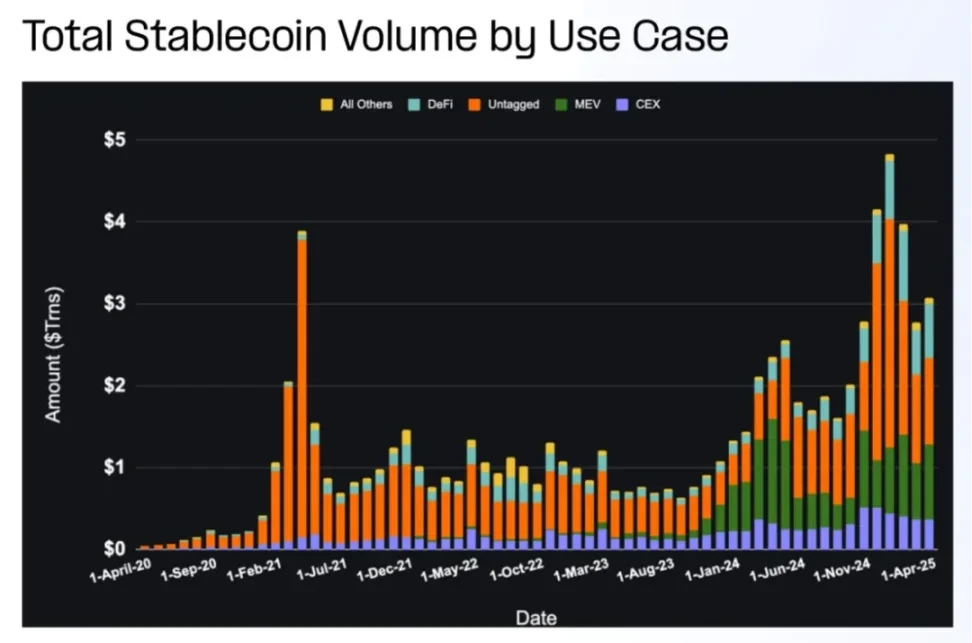
Total stablecoin volume has been climbing steadily since the summer of 2023, with unusual spikes during times of high market activity. DeFi has seen the highest volume increases, while MEV and untagged wallets have high but volatile volumes.
Entities with the highest stablecoin trading volume tend to be centralized exchanges, followed by DeFi and issuers. CEX trading volume does not reflect transactions on CEX platforms, as most transactions occur off-chain. Instead, it reflects user deposits and withdrawals, inter-exchange transfers, and internal operational activities.
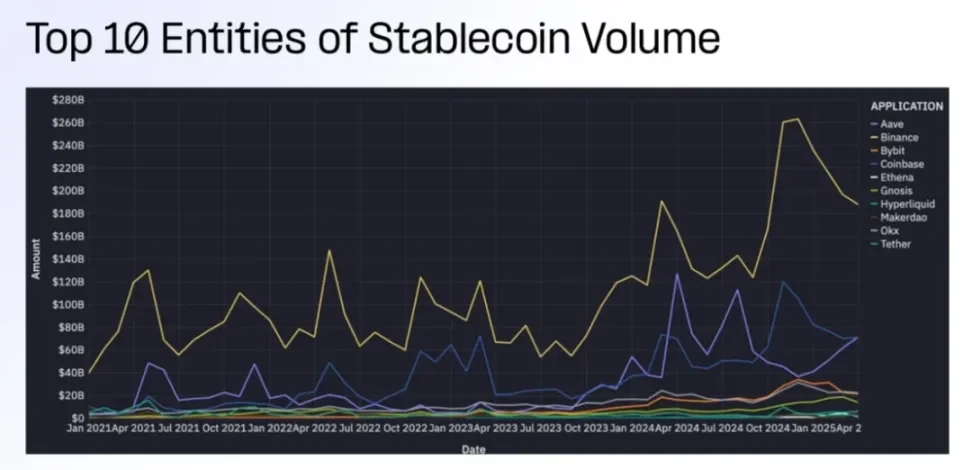
3.2 Centralized Exchange (CEX)
The supply of stablecoins anchored by centralized exchanges accounts for a large portion of the circulation in the ecosystem. In terms of trading volume, DeFi protocols and MEV-driven participants are currently the most active, highlighting the growing role of on-chain applications and composable infrastructure.
Total stablecoin supply: 27%
Total stablecoin trading volume in the past 30 days: 11%
Reserve income: $3 billion
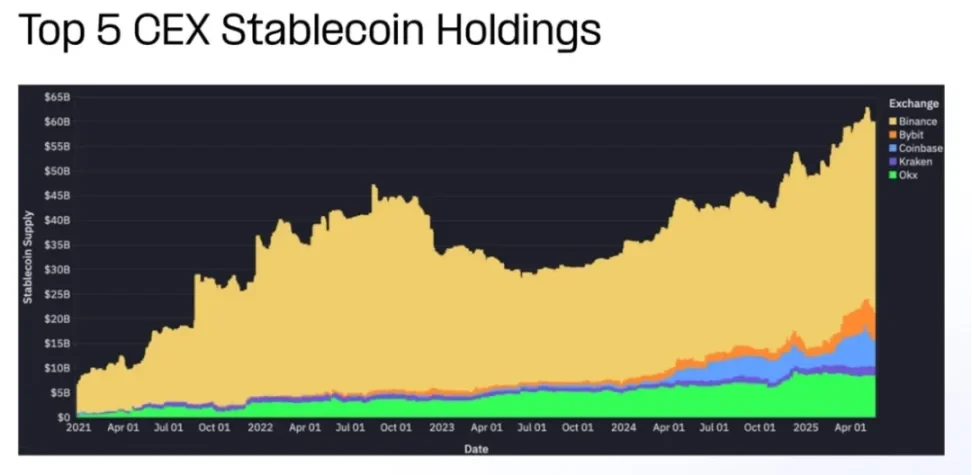
Supply on top centralized exchanges (CEXs) has nearly doubled since local lows in 2023. Supply on Coinbase, Binance, and Bybit tends to fluctuate with the market, while supply on Kraken and OKX has grown more steadily.
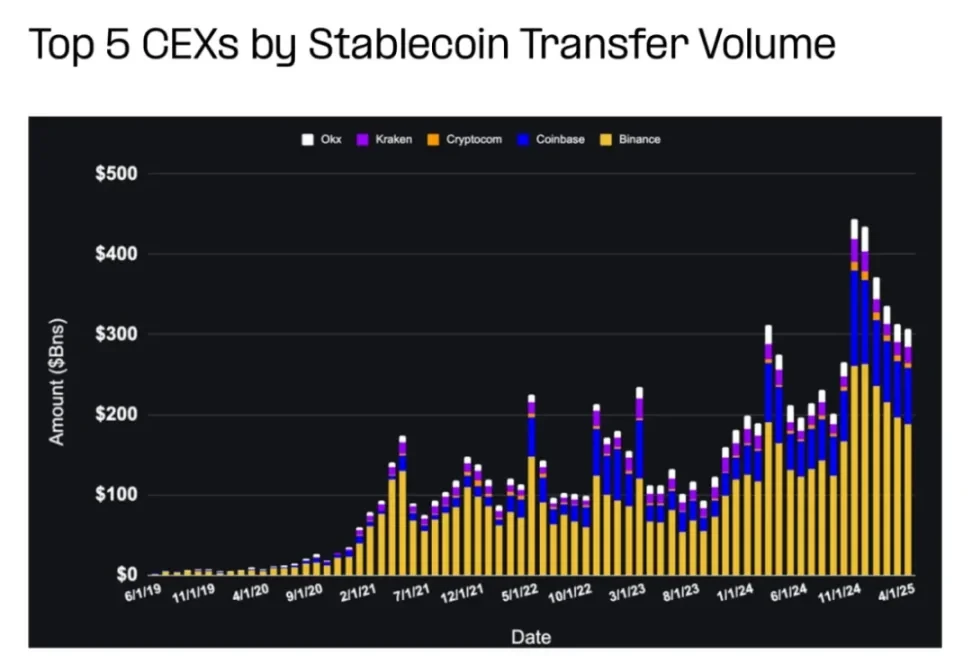
It is difficult to obtain specific data on how stablecoins are used by centralized exchanges (CEXs) because most of the activity occurs off-chain (centralized ledgers). Funds are often pooled together and their specific uses are rarely disclosed. This opacity makes it difficult to assess the full scope of stablecoin usage within centralized exchanges (CEXs).
Stablecoin trading volume attributed to centralized exchanges (CEXs) reflects on-chain activity related to deposits, withdrawals, inter-exchange transfers, and liquidity operations, rather than internal trading, margin collateralization, or fee settlement. Therefore, it is best viewed as an indicator of user interaction with exchanges rather than a measure of total trading activity.
3.3 Decentralized Finance (DeFi)
Total stablecoin supply: 11%
Total stablecoin trading volume in the past 30 days: 21%
Reserve income: $1.1 billion
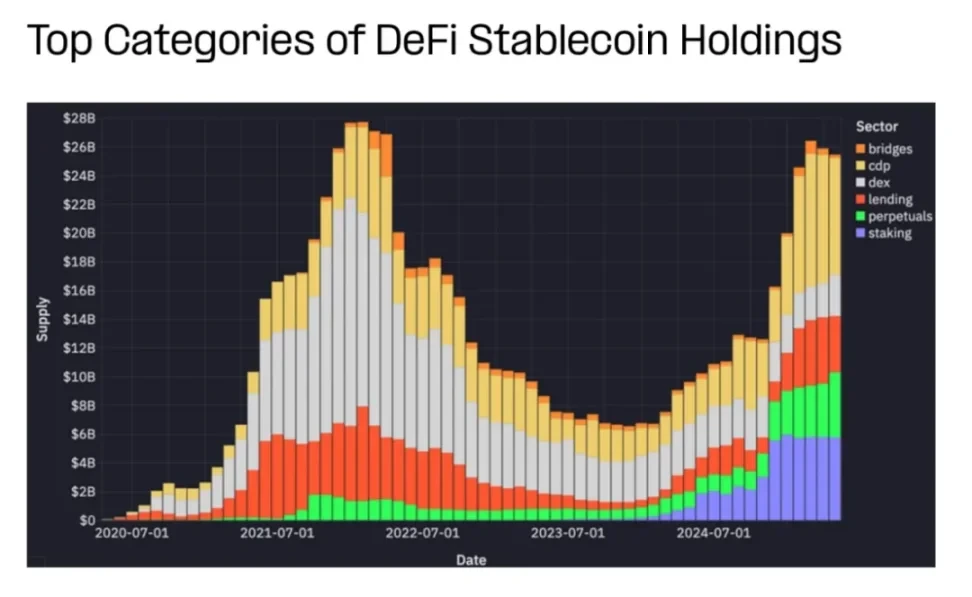
The supply of DeFi stablecoins comes from collateral, liquidity provider (LP) assets, and the settlement layer of lending markets, decentralized exchanges (DEX), and derivatives protocols. In the past six months, the supply of CDPs, lending, perpetual contracts, and staking has almost doubled.
The supply share of DEXs has dropped significantly, not because of a drop in DEX usage, but because DEXs are more capital efficient. With the popularity of Hyperliquid, the supply locked in perpetual contracts has increased significantly recently.
Over the past six months, monthly trading volume of DeFi stablecoins has grown from approximately $100 billion to over $600 billion, driven primarily by significant growth in decentralized exchanges (DEXs), lending markets, and collateralized debt positions (CDPs).

In the DeFi field, stablecoins are used in the following key areas:
DEX Funding Pool
Lending Market
Asset-backed claims
Others (including perpetual contracts, cross-chain and staking)
Each sector uses stablecoins differently — whether as liquidity, collateral, or a method of payment — which affects user behavior and the economics of the protocol layer.
A. DEX
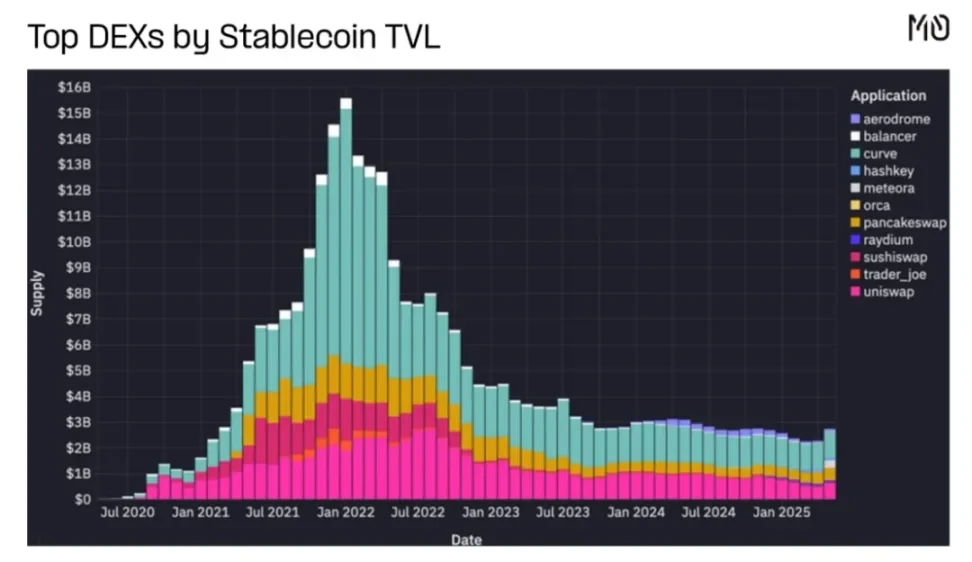
Centralized liquidity, stablecoin-centric DEXs, and cross-protocol composability reduce the need for DEXs to maintain high stablecoin floats.
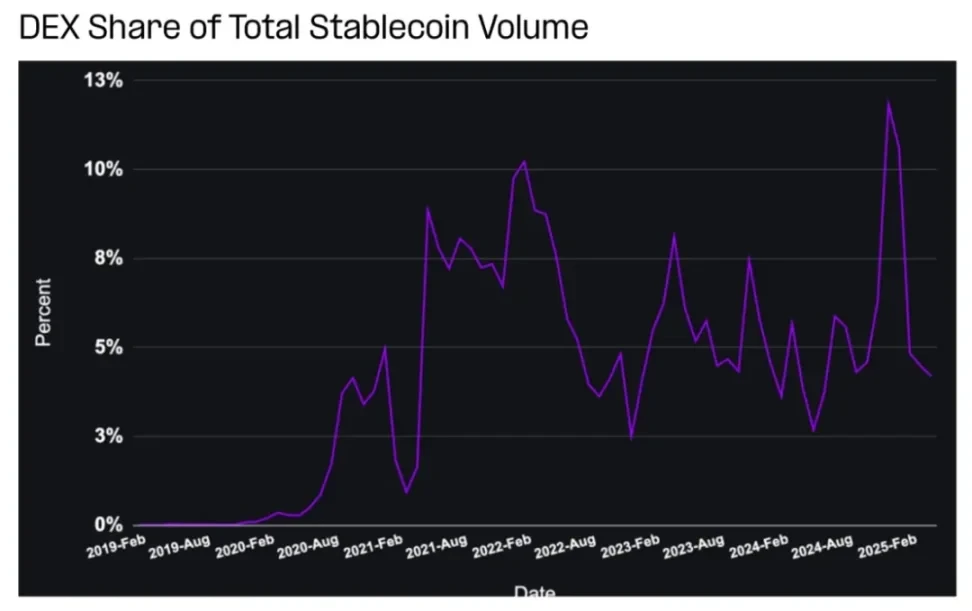
Most of the stablecoin trading volume in DeFi comes from DEX. The share of DEX in total trading volume fluctuates with market sentiment and trading trends. Recently, the trading volume of memecoin has soared to more than $500 billion, accounting for 12% of the total trading volume.
B. Lending Markets
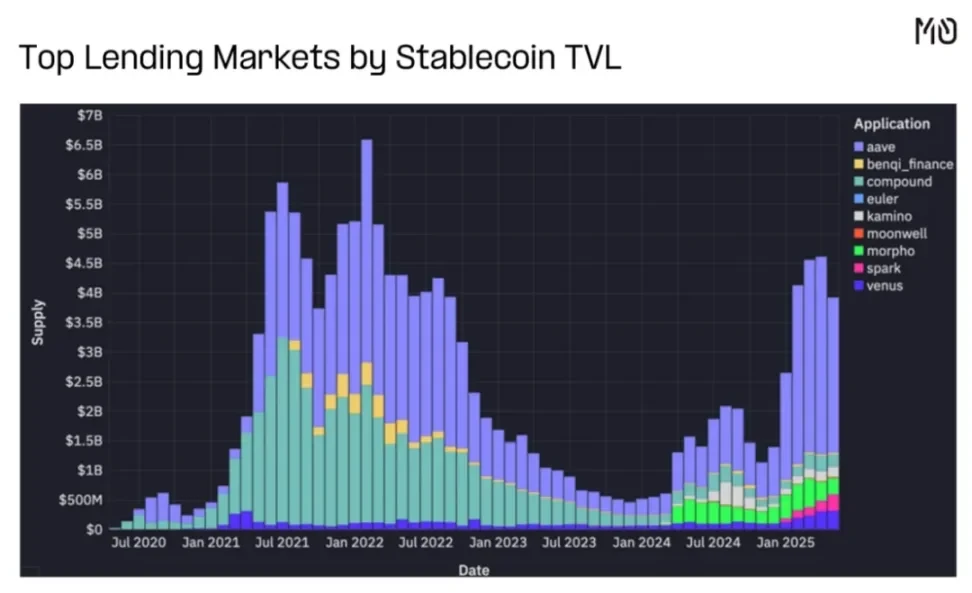
Although lending has fallen from its peak, Aave has shown strong recovery momentum, while new protocols such as Morpho, Spark, and Euler have also gained traction.
C. Collateralized Debt Positions
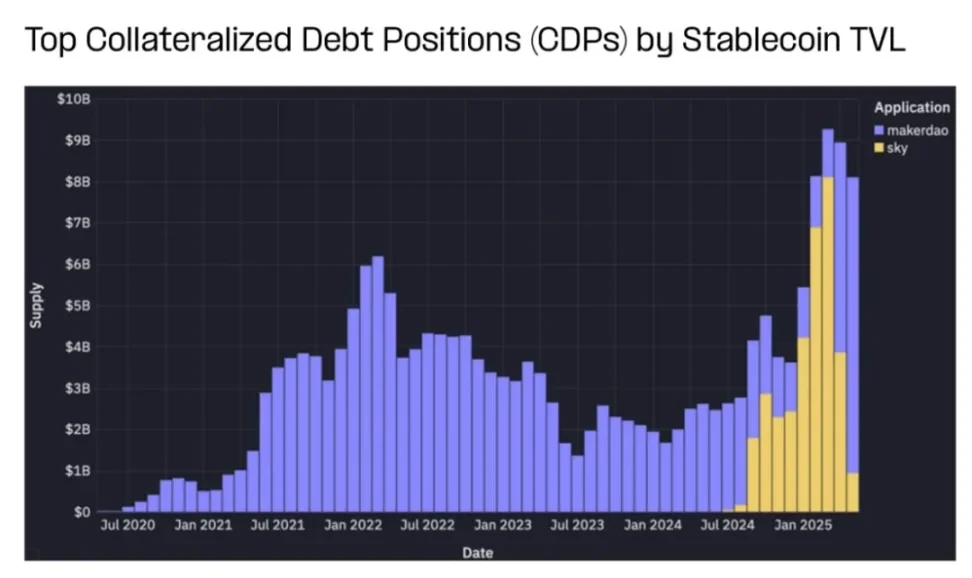
MakerDAO continues to manage one of the largest stablecoin pools in DeFi, with DAI adoption growing, driven by high savings rates. They hold billions of dollars in stablecoins and play a key role in maintaining DAI’s peg to the USD.
D. Others
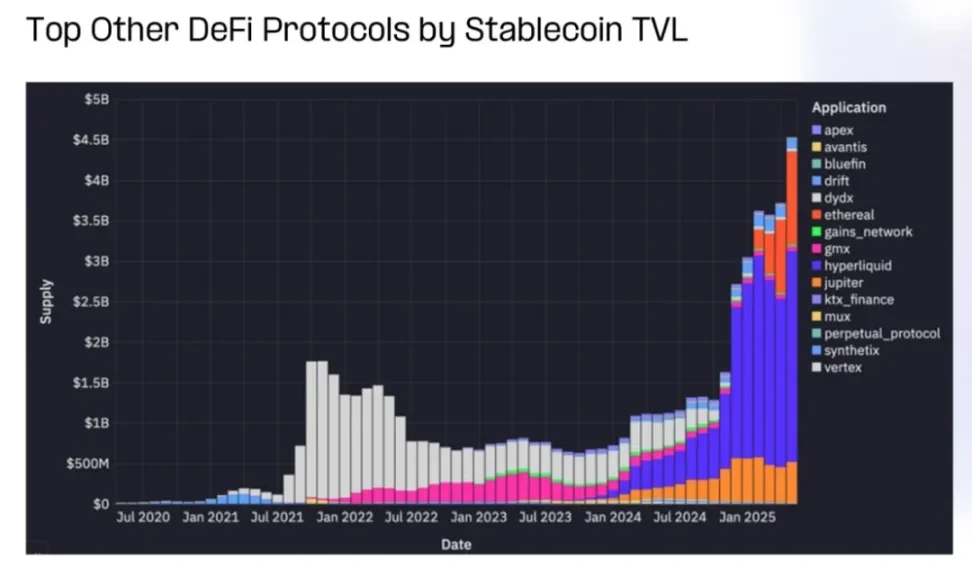
Stablecoins also play a key role in supporting DeFi derivatives, synthetic assets, perpetual contracts, and trading protocols.
Over time, the supply of stablecoins rotates between various perpetual swap protocols, currently concentrated on Hyperliquid, Jupiter, and Ethereal.
3.4 MEV Miner/Node Verification
Total stablecoin supply: < 1%
Total stablecoin trading volume in the past 30 days: 31%
Reserve income: /

MEV bots extract value by reordering transactions. Their high-frequency behavior causes a disproportionate share of on-chain transactions, and they often reuse the same funds.
The above chart separates MEV-driven activity to distinguish between bot volume and manual volume. MEV volume surges during peak trading periods and fluctuates as blockchains and applications try to counter MEV strategies.
Predicting revenue for a high volume, low float use case like MEV is not as straightforward as predicting high float use cases. Predicting reserve yields is less applicable here, but these use cases can employ a variety of monetization strategies such as transaction fees, spread capture, embedded financial services, and application-specific monetization.
3.5 Unattributed Wallets
Total stablecoin supply: 54%
Total stablecoin trading volume in the past 30 days: 35%
Reserve income: $5.6 billion
Stablecoin activity in unlabeled wallets is more difficult to interpret, as the intent behind transactions must be inferred or confirmed through private data. Even so, these wallets account for the vast majority of stablecoin supply and often the majority of transaction volume.
The components of the unlabeled wallet include:
Retail users
Unidentified institution
Startups and SMEs
Dormant or passive holders
Unclassified smart contracts
While attribution models are imperfect, these “gray area” wallets account for an increasing share of real-world payment, savings, and operational processes, many of which do not fully match traditional DeFi or trading frameworks.
Some of the most promising use cases are emerging, including:
P2P Remittance
Treasury Management for Startups
US dollar savings of individuals in inflationary economies
Cross-border B2B payments
E-commerce and merchant settlement
In-game economy
As regulatory clarity improves and payments-centric infrastructure continues to attract capital, these emerging use cases are expected to expand rapidly, especially in regions underserved by traditional banks.
Related content can be found: Artemis: First-line data from stablecoin payment adoption

For now, we will focus on the following high-level trends:
Despite the large number of unvested wallets (over 150 million), the vast majority hold negligible balances. More than 60% of unvested wallets hold less than $1 in stablecoins, while fewer than 20,000 wallets hold more than $1 million in stablecoins.
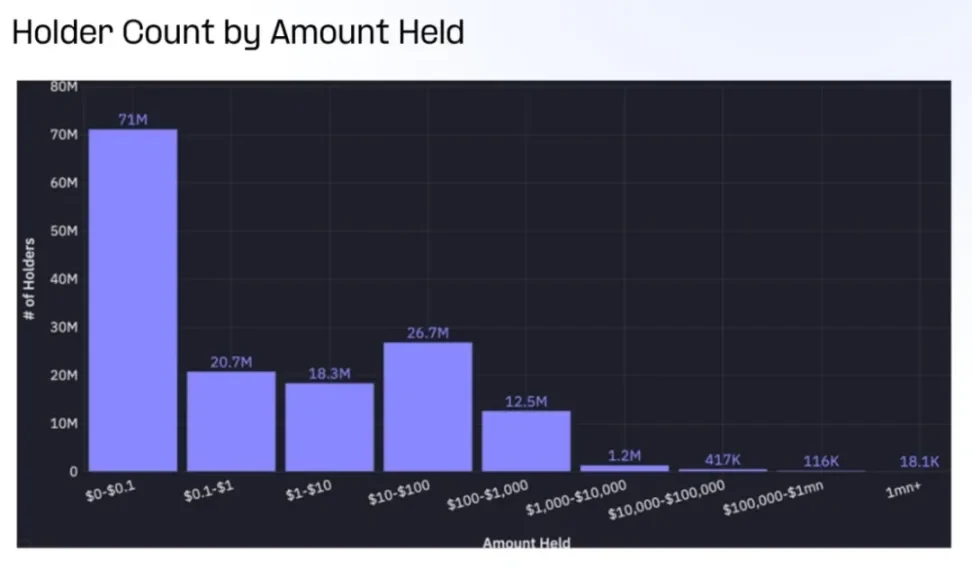
When we shift the focus to each wallet balance, the situation is completely reversed.
There are less than 20,000 unvested wallets with balances exceeding $1 million, holding a total of more than $76 billion, or 32% of the total stablecoin supply.
Meanwhile, wallets with balances below $10,000 (which make up more than 99% of unvested wallets) hold a total of $9 billion, less than 4% of the total stablecoin supply.
Most wallets are small, but most unvested stablecoins are in the hands of a small number of high-value groups. This distribution reflects the dual nature of stablecoin use: on the one hand, there are broad grassroots users, and on the other hand, there is a high concentration of institutional users or whale users.
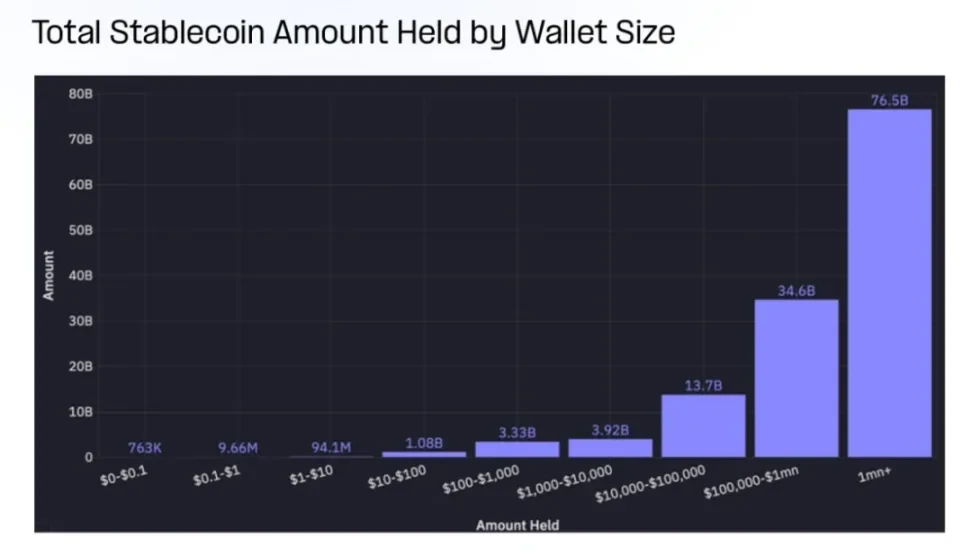
IV. Conclusion
The stablecoin ecosystem has entered a new phase where value will increasingly flow to those who build applications and infrastructure.
This marks a critical maturity of the market, with the focus shifting from the currency itself to the programmable systems that make it work. As regulatory frameworks improve and user-friendly applications proliferate, stablecoins will see exponential growth. They combine the stability of fiat currencies with the programmability of blockchains, making them the cornerstone of future global finance.
The future of stablecoins belongs to those who build the applications, infrastructure, and experiences that unlock their full potential. As this shift accelerates, we can expect more innovation in how value is created, distributed, and captured across the ecosystem.
The future financial world will not be defined solely by stablecoins, but by the ecosystem that forms around them.










